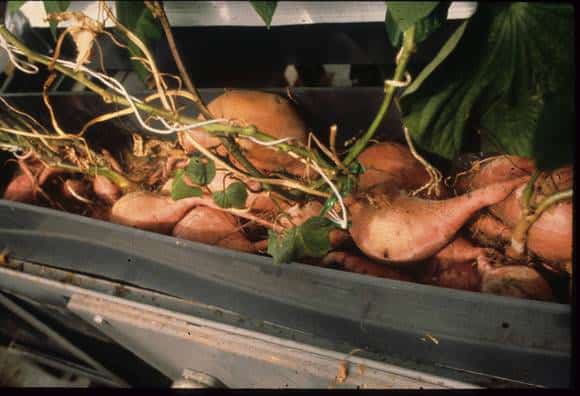The First Candy Potato Area Travellers – The Unconventional Gardener
Header picture: Candy potato cuttings grown in an Alabama laboratory had been flown aboard house shuttle Columbia to check root development in microgravity. Picture credit score: NASA.
As at the moment is Thanksgiving in the US, I believed I’d share a narrative from the archives a couple of journey that candy potatoes took into house.
The yr was 1999, and researchers from Tuskegee College had been working with NASA to search out methods to develop and use peanuts and candy potatoes on long-term missions. The work stemmed from NASA grants provided within the Eighties, for researchers to review methods to develop greens focused nearly as good meals for long-term house journey. Tuskegee selected candy potatoes and later peanuts due to prior analysis executed on the college by George Washington Carver.
On account of their analysis, the staff launched a candy potato experiment on house shuttle Colombia, mission STS-93, on 23 July 1999. Colombia spent nearly 5 days in house, returning to Earth on 28 July. NASA astronaut Eileen Collins turned the primary feminine shuttle Commander on that flight, which launched the Chandra X-ray Observatory.
On the time, seeds of a number of crops had been grown in microgravity, however this was the primary take a look at for vegetation grown from cuttings. As cuttings develop roots sooner than seeds, and candy potato cuttings regenerate very simply, they had been a really perfect topic for examine in the course of the shuttle mission. An an identical set of cuttings remained at Kennedy Area Middle in Florida, because the ground-based management group for the experiment.
Dr Desmond Mortley was an affiliate professor engaged on the undertaking. By the start of August, he’d collected the space-flown samples from Cape Canaveral and returned with them to Tuskegee.
‘We despatched up candy potato cuttings to see how they may do in house and whether or not microgravity impacts starch storage of their roots.”
Dr Desmond Mortley
The staff had been investigating whether or not gravity impacts starch, and so whether or not microgravity might restrict the provision of the carbohydrates wanted to help root development (and feed spacefarers).
They printed their ends in the Journal of the American Society for Horticultural Science in 2008.
Each units of cuttings confirmed related root development improvement, though the microgravity roots tended to develop perpendicular to the cuttings. The variety of roots was nearly the identical in each samples. Nonetheless, the size of roots grown in microgravity was considerably larger.
The microgravity cuttings contained extra soluble sugars and better starch concentrations than the bottom cuttings, with smaller starch grains.
The examine efficiently confirmed that stem cuttings, at the least these began in regular gravity circumstances, can regenerate roots in microgravity.
“This implies that the house flight setting has no adverse impact on the flexibility of vegetative cuttings to type roots and that use of cuttings needs to be a suitable means for propagating candy potato for future house functions,” the researchers concluded.
Candy potatoes are nonetheless thought-about an important a part of the food regimen for future house explorers. Final yr, a staff from the College of Nottingham and the College of Adelaide used a computational mannequin to design the proper house salad, which included candy potatoes, kale, soybeans, barley, peanuts, and poppy and sundlower seeds:
References:
Workers author, “College sends candy potatoes to house”, The Ledger, 2 August 1999. https://eu.theledger.com/story/information/1999/08/02/university-sends-sweet-potatoes-to-space/26690666007/
Senator Sam Brownback, “NASA AND EDUCATION HEARING earlier than the SUBCOMMITTEE ON SCIENCE, TECHNOLOGY, AND SPACE OF THE COMMITTEE ON COMMERCE, SCIENCE, AND TRANSPORTATION UNITED STATES SENATE”, 19 June 2002. https://www.govinfo.gov/content material/pkg/CHRG-107shrg91230/html/CHRG-107shrg91230.htm
Mortley, Desmond G., et al. “Affect of microgravity setting on root development, soluble sugars, and starch focus of sweetpotato stem cuttings.” Journal of the American Society for Horticultural Science 133.3 (2008): 327-332. https://journals.ashs.org/jashs/view/journals/jashs/133/3/article-p327.xml
Journal of the American Society for Horticultural Science, “Candy potato takes a experience on house shuttle”, EurekAlert!, 17 February 2009. https://www.eurekalert.org/news-releases/857306
Except in any other case acknowledged, © Copyright Emma Doughty 2024. Revealed on theunconventionalgardener.com.
Should you loved this publish, please take into account supporting my work. I’ve a subscriber-only Patreon for house plant lovers, or you possibly can simply purchase me a cup of tea:
Many thanks!




















